Related Research Articles

A fumarole is a vent in the surface of the Earth or another rocky planet from which hot volcanic gases and vapors are emitted, without any accompanying liquids or solids. Fumaroles are characteristic of the late stages of volcanic activity, but fumarole activity can also precede a volcanic eruption and has been used for eruption prediction. Most fumaroles die down within a few days or weeks of the end of an eruption, but a few are persistent, lasting for decades or longer. An area containing fumaroles is known as a fumarole field.

Arsenopyrite is an iron arsenic sulfide (FeAsS). It is a hard metallic, opaque, steel grey to silver white mineral with a relatively high specific gravity of 6.1. When dissolved in nitric acid, it releases elemental sulfur. When arsenopyrite is heated, it produces sulfur and arsenic vapor. With 46% arsenic content, arsenopyrite, along with orpiment, is a principal ore of arsenic. When deposits of arsenopyrite become exposed to the atmosphere, the mineral slowly converts into iron arsenates. Arsenopyrite is generally an acid-consuming sulfide mineral, unlike iron pyrite which can lead to acid mine drainage.

Bornite, also known as peacock ore, is a sulfide mineral with chemical composition Cu5FeS4 that crystallizes in the orthorhombic system (pseudo-cubic).

Forsterite (Mg2SiO4; commonly abbreviated as Fo; also known as white olivine) is the magnesium-rich end-member of the olivine solid solution series. It is isomorphous with the iron-rich end-member, fayalite. Forsterite crystallizes in the orthorhombic system (space group Pbnm) with cell parameters a 4.75 Å (0.475 nm), b 10.20 Å (1.020 nm) and c 5.98 Å (0.598 nm).

Alunite is a hydroxylated aluminium potassium sulfate mineral, formula KAl3(SO4)2(OH)6. It was first observed in the 15th century at Tolfa, near Rome, where it was mined for the manufacture of alum. First called aluminilite by J.C. Delamétherie in 1797, this name was contracted by François Beudant three decades later to alunite.

Cotunnite is the natural mineral form of lead(II) chloride (PbCl2). Unlike the pure compound, which is white, cotunnite can be white, yellow, or green. The density of mineral samples spans range 5.3–5.8 g/cm3. The hardness on the Mohs scale is 1.5–2. The crystal structure is orthorhombic dipyramidal and the point group is 2/m 2/m 2/m. Each Pb has a coordination number of 9. Cotunnite occurs near volcanoes: Vesuvius, Italy; Tarapacá, Chile; and Tolbachik, Russia.
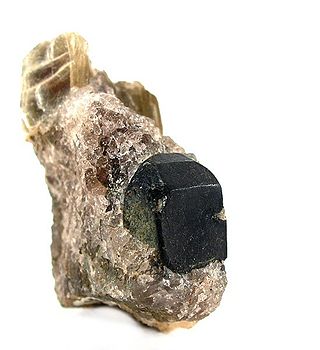
Triphylite is a lithium iron(II) phosphate mineral with the chemical formula LiFePO4. It is a member of the triphylite group and forms a complete solid solution series with the lithium manganese(II) phosphate, lithiophilite. Triphylite crystallizes in the orthorhombic crystal system. It rarely forms prismatic crystals and is more frequently found in hypidiomorphic rock. It is bluish- to greenish-gray in color, but upon alteration becomes brown to black.
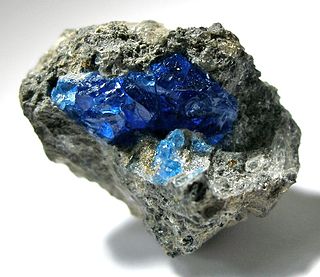
Hauyne or haüyne, also called hauynite or haüynite, is a Rare tectosilicate sulfate mineral with endmember formula Na3Ca(Si3Al3)O12(SO4). As much as 5 wt % K2O may be present, and also H2O and Cl. It is a feldspathoid and a member of the sodalite group. Hauyne was first described in 1807 from samples discovered in Vesuvian lavas in Monte Somma, Italy, and was named in 1807 by Brunn-Neergard for the French crystallographer René Just Haüy (1743–1822). It is sometimes used as a gemstone.
Ziesite is a copper vanadate mineral with formula: β-Cu2V2O7. It was discovered in 1980 as monoclinic crystals occurring as volcanic sublimates around fumaroles in the crater of the Izalco Volcano, El Salvador. It is named after Emanuel George Zies (1883–1981), an American geochemist who studied Izalco in the 1930s.
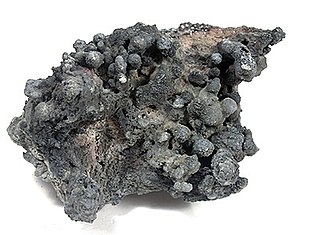
Rheniite is a very rare rhenium sulfide mineral with the chemical formula. It forms metallic, silver grey platey crystals in the triclinic - pinacoidal class. It has a specific gravity of 7.5.
Lyonsite (Cu3Fe+34(VO4)6) is a rare black vanadate mineral that is opaque with a metallic lustre. It crystallizes in the orthorhombic crystal system. Lyonsite often occurs as small tabular typically well formed crystals. Lyonsite has a good cleavage and a dark gray streak.
Dimorphite, chemical name arsenic sesquisulfide (As4S3), is a very rare orange-yellow arsenic sulfide mineral. In nature, dimorphite forms primarily by deposition in volcanic fumaroles at temperatures of 70–80 °C (158–176 °F). Dimorphite was first discovered in such a fumarole near Naples, Italy in 1849 by the mineralogist Arcangelo Scacchi (1810–1893). Since its discovery, dimorphite has been found in the Alacrán silver mine near Copiapó, Chile. It has also been reported from Cerro de Pasco, Peru, and the Lavrion District Mines in Attica, Greece.

Bararite is a natural form of ammonium fluorosilicate (also known as hexafluorosilicate or fluosilicate). It has chemical formula (NH4)2SiF6 and trigonal crystal structure. This mineral was once classified as part of cryptohalite. Bararite is named after the place where it was first described, Barari, India. It is found at the fumaroles of volcanoes (Vesuvius, Italy), over burning coal seams (Barari, India), and in burning piles of anthracite (Pennsylvania, U.S.). It is a sublimation product that forms with cryptohalite, sal ammoniac, and native sulfur.

Avogadrite ((K,Cs)BF4) is a potassium-caesium tetrafluoroborate in the halide class. Avogadrite crystallizes in the orthorhombic system (space group Pnma) with cell parameters a 8.66 Å, b 5.48 Å and c Å 7.03.

Alum-(K) is a hydrous potassium aluminium sulfate mineral with formula KAl(SO4)2·12(H2O). It is the mineral form of potassium alum and is referred to as potassium alum in older sources. It is a member of the alum group.
Blossite is an anhydrous copper vanadate mineral with the formula: Cu2+V5+2O7. Blossite was named for mineralogist F. Donald Bloss of Virginia Polytechnic Institute and State University.
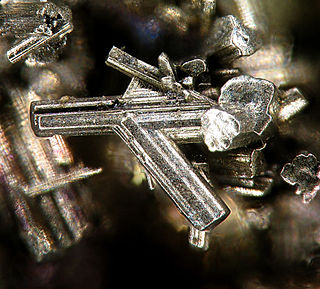
Argentopyrite is a moderately rare sulfide mineral with the chemical formula AgFe2S3. It is one of the natural compounds of the MFe2S3 type, with M being caesium in very rare pautovite, copper in relatively common cubanite, potassium in rare rasvumite and thallium in rare picotpaulite. The type locality is Jáchymov in Czech Republic. Chemically similar mineral include sternbergite, lenaite, AgFeS2, and argentopentlandite, Ag(Fe,Ni)8S8.
Wulffite is an alkali copper sulfate mineral with the chemical formula K3NaCu4O2(SO4)4, in the sulfate category of minerals. It was recently discovered in Kamchatka, Russia at the Tolbachik volcano in 2012. It was named for Russian crystallographer Georgiy Viktorovich Wulff, a renowned expert who furthered X-ray diffraction and interference. Wullfite shares many properties with parawulffite, which was found in the same area just with slightly different chemical composition.
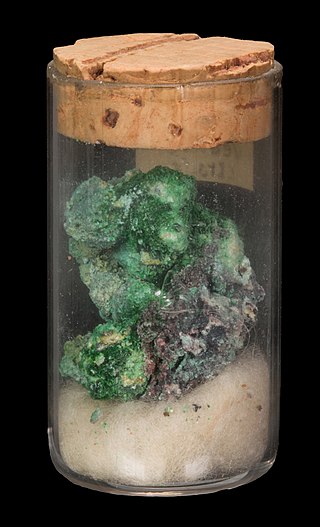
Euchlorine (KNaCu3(SO4)3O) is a rare emerald-green sulfate mineral found naturally occurring as a sublimate in fumaroles around volcanic eruptions. It was first discovered in fumaroles of the 1868 eruption at Mount Vesuvius in Campania, Italy by Arcangelo Scacchi. The name 'euchlorine' comes from the Greek word εΰχλωρος meaning "pale green" in reference to the mineral's color, other reported spellings include euclorina, euchlorin, and euchlorite.

Fumarole minerals are minerals which are deposited by fumarole exhalations. They form when gases and compounds desublimate or precipitate out of condensates, forming mineral deposits. They are mostly associated with volcanoes following deposition from volcanic gas during an eruption or discharge from a volcanic vent or fumarole, but have been encountered on burning coal deposits as well. They can be black or multicoloured and are often unstable upon exposure to the atmosphere.
References
- ↑ Warr, L.N. (2021). "IMA–CNMNC approved mineral symbols". Mineralogical Magazine. 85 (3): 291–320. Bibcode:2021MinM...85..291W. doi: 10.1180/mgm.2021.43 . S2CID 235729616.
- ↑ Mineralienatlas
- 1 2 3 4 5 6 7 8 9 10 11 12 13 14 Ostrooumov, M., Taran, Y., Arellano-Jimenez, M., Ponse, A., and Reyes-Gasga, J. (2009) Colimaite, K3VS4 – anew potassium-vanadium sulfide mineral from the Colima volcano, State of Colima (Mexico) Revista Mexicana de Ciencias Geológicas, 26(3), 600-608
- ↑ Jugo, P.J. (2009), Sulfur content at sulfide saturation in oxidized magmas. Geology, 37(5), 415-418
- ↑ Klein, C., and Dutow, B. (2008) The 23rd Edition of the Manual of Mineral Science. Jay O'Callaghan
- ↑ Taran, Y. A., Bernard, A., Gavilanes, J., and Africano, F. (2000) Native gold in mineral precipitates from high-temperature volcanic gases of Colima volcano, Mexico. Applied Geochemistry, 15, 337-346